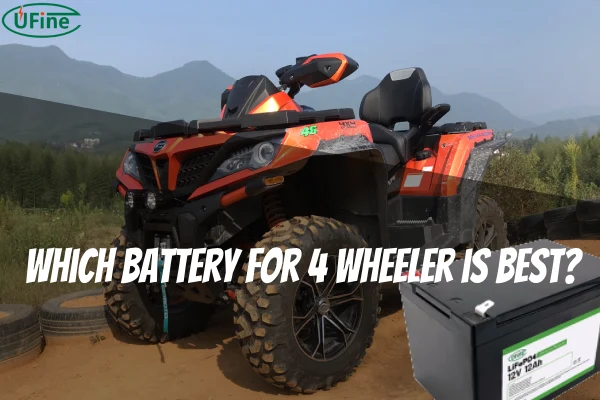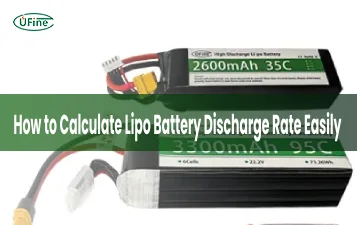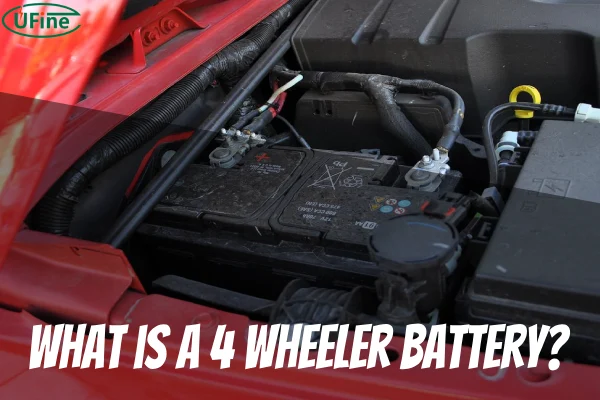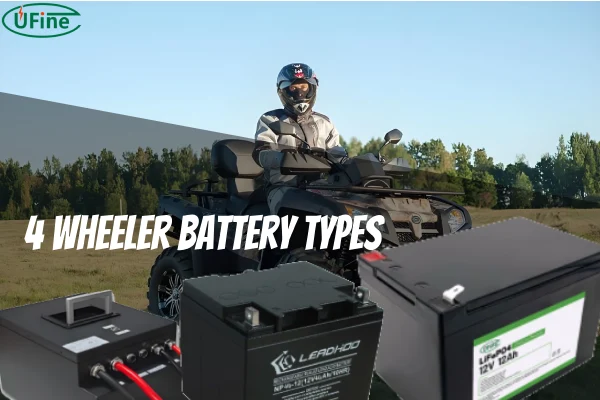The heart of your ATV, the engine, relies on a silent but powerful force: the battery. It’s not just about starting the engine; it powers your lights, winches, and even GPS systems. Choosing the right battery can ensure reliable performance, extended adventures, and peace of mind. This guide will unravel the mysteries of 4-wheeler batteries, equipping you with the knowledge to make the best choice for your riding needs.
Part 1. What is a 4-wheeler battery?
A 4-wheeler battery is a specialized power source designed to withstand the rigors of off-road adventures. Unlike car batteries, which primarily focus on starting the engine, 4-wheeler batteries need to deliver consistent power for extended periods, endure vibrations, and operate in extreme temperatures. They are the backbone of your ATV’s electrical system, powering everything from the ignition to your accessories.
Part 2. 4 wheeler battery key parameters
To understand the nuances of 4-wheeler batteries, we need to go beyond the basics and explore their key parameters in detail:
1. Voltage:
- The Foundation of Power: The standard voltage for most 4-wheeler batteries is 12V. This voltage is crucial for powering the ATV’s electrical system efficiently.
- Matching the System: If your ATV has a 12V system, using a 12V battery is essential for optimal performance and safety. Using a battery with a different voltage can damage your ATV’s electrical components.
- High-Performance Considerations: Some high-performance ATVs may utilize higher voltage batteries, typically 14V or 16V. These batteries require specialized wiring and components, so consult your ATV’s manual or a qualified mechanic before making any changes.
2. Capacity (Amp-Hours, Ah):
- The Power Reservoir: Amp-hours (Ah) measure the battery’s capacity to deliver power over time. A higher Ah rating indicates a larger power reservoir, allowing your ATV to run for longer periods before needing a recharge.
- Matching Your Riding Style: Casual riders who primarily use their ATVs for short trips might be satisfied with a smaller Ah rating. However, serious off-road enthusiasts who embark on extended adventures or utilize power-hungry accessories like winches will benefit from a higher Ah rating.
- Understanding the Trade-off: A higher Ah rating generally translates to a heavier battery, which can impact your ATV’s handling and fuel efficiency.
3. Cold Cranking Amps (CCA):
- Starting Power in the Cold: CCA measures the battery’s ability to deliver a high current to start the engine in cold temperatures. A higher CCA rating is crucial for reliable starting in freezing conditions.
- Climate Considerations: If you live in a cold climate or frequently ride in winter conditions, prioritize a battery with a high CCA rating.
- Beyond Starting: CCA also plays a role in powering accessories, especially those that draw high current, like winches.
4. Reserve Capacity (RC):
- Emergency Power: Reserve Capacity (RC) indicates how long the battery can power essential systems (like headlights and taillights) if the charging system fails.
- Peace of Mind: A higher RC rating provides peace of mind, ensuring you can safely navigate back to civilization if your charging system malfunctions.
- Beyond the Basics: RC is also a good indicator of the battery’s overall health and ability to handle deep discharges.
5. Dimensions:
- A Perfect Fit: The physical dimensions of the battery must fit securely into your ATV’s battery compartment.
- Checking Compatibility: Consult your owner’s manual for the recommended battery size, or contact your local ATV dealer for compatibility information.
- Space Matters: A tight fit can restrict airflow and heat dissipation, potentially affecting the battery’s performance and lifespan.
6. Weight:
- Handling and Performance: The battery’s weight can affect your ATV’s handling, acceleration, and fuel efficiency.
- Lightweight Advantage: Lighter batteries are generally preferred for better maneuverability, especially for those who frequently ride in challenging terrain.
- Balancing the Scales: While a heavier battery might provide more power, it’s important to consider the impact on your ATV’s overall performance.
7. Terminal Type:
- Secure Connections: The battery terminals must be compatible with your ATV’s wiring system.
- Common Terminal Types: Common terminal types include top post, side post, and quick-connect terminals. Ensure the terminals match your ATV’s connectors for a secure connection.
- Avoiding Issues: Incompatible terminals can lead to loose connections, electrical problems, and even damage to your ATV’s wiring system.
Part 3. 4 wheeler battery types
Understanding the different types of 4-wheeler batteries is crucial for making an informed decision:
1. Lead-Acid Batteries:
- The Traditional Choice: Lead-acid batteries are the most traditional type, known for their affordability and widespread availability. They are familiar to most mechanics, making maintenance and replacement relatively straightforward.
- Maintenance Requirements: Lead-acid batteries require regular maintenance, including checking water levels and cleaning terminals. Neglecting maintenance can lead to sulfation, reducing the battery’s capacity and lifespan.
- Durability Considerations: Lead-acid batteries are generally less durable than other types, especially in harsh conditions. They are more susceptible to vibrations, extreme temperatures, and deep discharges.
- Suitable for: Budget-conscious riders who are comfortable with basic maintenance and primarily use their ATVs for casual riding.
2. AGM (Absorbent Glass Mat) Batteries:
- Maintenance-Free Convenience: AGM batteries are a popular choice for 4-wheelers due to their sealed and maintenance-free design. They are convenient for riders who prefer minimal upkeep.
- Enhanced Durability: AGM batteries are more resistant to vibrations and extreme temperatures than lead-acid batteries, making them suitable for off-road use. They also have a longer lifespan, offering better value for money.
- Performance Considerations: AGM batteries generally offer good performance in most conditions, but they may not perform as well in extremely cold temperatures as lithium-ion batteries.
- Suitable for: Riders who prioritize convenience, durability, and a longer lifespan, without sacrificing performance.
- The Future of Power: Lithium-ion batteries represent the cutting edge of battery technology. They are lightweight, offer the longest lifespan, and charge quickly, making them ideal for serious off-road enthusiasts.
- Exceptional Performance: Lithium-ion batteries excel in extreme temperatures, providing reliable starting power even in freezing conditions. They also deliver consistent power output, even under heavy loads.
- Cost Considerations: Lithium-ion batteries are the most expensive option, but their superior performance, longevity, and weight savings often justify the investment for those who prioritize performance and value.
- Suitable for: Riders who prioritize performance, longevity, weight reduction, and are willing to invest in the latest technology.
4. Gel Batteries:
- Spill-Proof and Durable: Gel batteries use a gel electrolyte, making them spill-proof and safe for off-road use. They are also resistant to vibrations, making them suitable for ATVs with demanding applications.
- Deep-Cycle Applications: Gel batteries are well-suited for deep-cycle applications, such as powering winches, where the battery is repeatedly discharged and recharged.
- Limited Availability: Gel batteries are less common in ATVs than lead-acid and AGM batteries, making them more difficult to find and potentially more expensive.
- Suitable for: Riders who need a battery for deep-cycle applications, prioritize spill-proof operation, and are willing to pay a premium for specialized features.
AGM VS Lithium VS Lead-Acid Battery: Comprehensive Comparison
Part 4. Which battery for 4 wheeler is best?

Selecting the best battery for your ATV involves considering your riding style, budget, and environmental conditions. Here’s a detailed comparison of the different battery types, highlighting their strengths and weaknesses:
| Feature | Lead-Acid | AGM | Lithium-Ion | Gel |
|---|---|---|---|---|
| Durability | Moderate | High | Very High | High |
| Weight | Heavy | Moderate | Very Light | Moderate |
| Maintenance | Required | None | None | None |
| Cost | Low | Moderate | High | Moderate |
| Lifespan | Short | Moderate | Long | Moderate |
| Cold Weather | Moderate | High | Very High | Moderate |
| Charging Time | Moderate | Moderate | Very Fast | Moderate |
1. Durability:
- Withstanding the Test: AGM and lithium-ion batteries offer superior durability, resisting vibrations and extreme temperatures better than lead-acid batteries. They are less likely to fail under harsh off-road conditions.
- Long-Term Performance: Durability translates to a longer lifespan, reducing the frequency of battery replacements and saving you money in the long run.
2. Weight:
- Handling and Performance: Lithium-ion batteries are the lightest option, offering significant weight savings compared to other types. This weight reduction improves your ATV’s handling, acceleration, and fuel efficiency.
- Maneuverability in Challenging Terrain: A lighter battery can make a noticeable difference in challenging terrain, allowing you to navigate tight corners and obstacles with greater ease.
3. Maintenance:
- Convenience and Cost Savings: AGM and gel batteries are maintenance-free, eliminating the need for regular water level checks and terminal cleaning. This saves you time and effort, and reduces the risk of damage caused by improper maintenance.
- Focus on Riding: With maintenance-free batteries, you can spend less time worrying about battery upkeep and more time enjoying your off-road adventures.
4. Cost:
- Budget Considerations: Lead-acid batteries are the most budget-friendly option, making them attractive for riders who prioritize affordability.
- Long-Term Value: While lithium-ion batteries have a higher upfront cost, their exceptional longevity and performance can justify the investment for serious riders. They can save you money in the long run by reducing the frequency of battery replacements.
5. Lifespan:
- Long-Term Investment: Lithium-ion batteries offer the longest lifespan, lasting several years longer than other types. This makes them a long-term investment, providing years of reliable performance.
- Minimizing Downtime: A longer lifespan reduces the frequency of battery replacements, minimizing downtime and ensuring you can always enjoy your ATV.
6. Cold Weather Performance:
- Reliable Starting: AGM batteries excel in cold conditions, providing reliable starting power even in freezing temperatures. They are a good choice for riders who live in cold climates or frequently ride in winter conditions.
- Consistent Performance: Lithium-ion batteries also perform well in cold weather, offering even better starting power than AGM batteries.
7. Charging Time:
- Minimizing Downtime: Lithium-ion batteries charge much faster than other types, minimizing downtime between rides. This is especially beneficial for riders who frequently use their ATVs or need to recharge quickly.
- Convenience and Efficiency: Fast charging times allow you to spend less time waiting for your battery to charge and more time enjoying your ATV.
Part 5. What kind of battery does my 4 wheeler need?
To determine the right battery for your ATV, consult your owner’s manual for specific recommendations. Consider these factors:
- Riding Style: Casual riders might be satisfied with a lead-acid battery, while frequent off-roaders might benefit from an AGM or Lithium-Ion battery.
- Climate: If you ride in cold weather, prioritize a battery with a high CCA rating.
- Accessories: If you use a winch or other power-hungry accessories, consider a battery with a higher capacity.
- Budget: Balance your budget with the long-term value and performance offered by different battery types.
Part 6. Maximizing battery life: maintenance and care
Proper maintenance and care are essential for maximizing the lifespan of your 4-wheeler battery, regardless of the type:
- Regular Charging: Always charge your battery after each ride, especially if you used power-hungry accessories.
- Avoid Deep Discharges: Deep discharges can damage the battery, reducing its capacity and lifespan.
- Clean Terminals: Clean the battery terminals regularly to ensure a good electrical connection.
- Store Properly: If you’re storing your ATV for an extended period, remove the battery and store it in a cool, dry place.
- Consult Your Owner’s Manual: Refer to your ATV’s owner’s manual for specific maintenance recommendations and charging instructions.
Related Tags:
More Articles

LiPo Battery Discharge Rate Guide & Calculation Tips
Understand LiPo battery discharge rates, C-ratings, and how to calculate max current. Essential guide for RC, drones, and electronics users.
High‑Capacity 3S LiPo Batteries: 5000 mAh vs. 10000 mAh
Compare 3S LiPo 5000mAh vs 10000mAh batteries by weight, power, and use. Find the best fit for your drone, RC car, or boat setup.
Top 5 Applications for Small 3S LiPo Batteries
Small 3S LiPo batteries power drones, RC gear, wearables, and robotics with high energy and low weight. Making them ideal for compact electronics projects.
Building and Charging Your Own 3S LiPo Pack: A Step‑by‑Step Guide
Learn how to build, balance, and charge a 3S LiPo battery pack safely at home with this complete DIY guide for hobbyists and beginners.
How to Choose the Right LiPo Battery Plug Type?
Discover the best LiPo battery plug types, how to choose them, and expert tips for safe usage, soldering, and maintenance.





